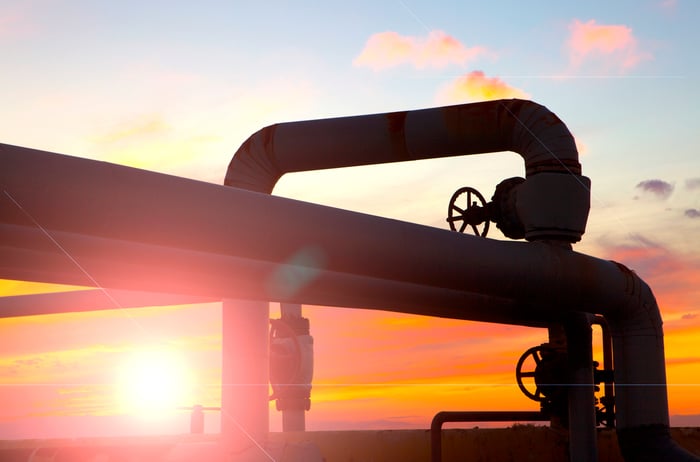Energy companies in North America need to invest an estimated $800 billion in building new infrastructure by 2035, according to a recent industry study. Of that amount, companies need to spend $321 billion on new oil-related infrastructure, like pipelines and storage terminals.
One company that's working hard to capture more of this massive opportunity is Phillips 66 (PSX 1.14%). The refining-and-logistics giant recently completed a multibillion-dollar oil pipeline from North Dakota to the Gulf Coast, which it subsequently sold to its master limited partnership (MLP) Phillips 66 Partners (PSXP). Meanwhile, its MLP is building an oil pipeline from the Permian Basin to the Texas coast, as well as a storage and export terminal. However, Phillips 66 sees the potential to capture even more opportunities to expand its oil-pipeline business, which led it to launch several new projects recently.

Image source: Getty Images.
Drilling down into the latest ideas
One of them is the Liberty Pipeline, which would move crude from the Rockies and Bakken production areas to Corpus Christi, TX. The pipeline would initially have the capacity to move 350,000 barrels per day (BPD), though Phillips 66 and its partner could expand it if they secure enough interested shippers. This pipeline could be in service by the end of 2020 if everything goes according to plan.
Meanwhile, the company also announced the development of the Red Oak Pipeline, which would move oil from a storage hub in Cushing, Oklahoma to Corpus Christi, Houston, and Beaumont, Texas. Red Oak would transport 400,000 BPD, though the company could expand that capacity if it secures enough interested shippers. Again, the proposed in-service date would be the fourth quarter of 2020.
Finally, Phillips 66's MLP announced that it's considering an expansion of the Gray Oak pipeline, which it's currently building from the Permian to Corpus Christi and other markets along the Coast. The company expects the 900,000 BPD pipeline to be in service by the end of next year. However, Phillips 66 Partners is looking into expanding its capacity if it secures enough shipper commitments. That project could start service a year after the completion of the main pipeline.

Image source: Getty Images.
What's fueling these developments?
All these projects share one thing in common: Each one would move domestically produced crude toward the Gulf Coast. That's worth noting for two reasons. First, Phillips 66 operates refineries along the coast, including in Sweeney, Texas, which is one of the termination points of Gray Oak. By increasing the supply of domestic crude to its refineries, Phillips 66 can cut its costs, which should boost its refining margins and profitability.
In addition to that, the company is building out its storage and export capabilities along the Gulf, which will grow its midstream earnings. One of its main developments is in Beaumont, TX, where the company now has the capacity to store 13.3 million barrels of petroleum products, after recently finishing 900,000 barrels of new storage. The company expects to boost its capacity to 14.6 million by year-end and has another 2.2 million barrels of crude-oil capacity that it intends on finishing by the first quarter of 2020. However, with more barrels potentially flowing to Beaumont by the end of 2020 if Red Oak moves forward, Phillips 66 could expand this facility further.
Phillips 66 Partners, meanwhile, is working with Buckeye Partners (BPL) and another refiner to build a new oil storage and export terminal in Corpus Christi. The South Texas Gateway Terminal will initially offer 3.4 million barrels of storage capacity along with two export docks that can load oil on to tankers that can take it to higher priced global markets.
However, in addition to that initial project, which should enter service by the end of next year, Buckeye Partners and Phillips 66 Partners have the space to build as much as 10 million barrels of storage capacity, as well as additional export docks. Because of that, it's possible that Phillips 66 Partners and Buckeye Partners could expand this facility if Phillips 66 builds Liberty and Red Oak, since they'd both flow into the area.
Building out an oil-infrastructure juggernaut
Phillips 66 is working hard to capture as much of the $321 billion oil infrastructure opportunity as it can. That's because it would help boost the company's refining margins, as well as increase its midstream earnings. On top of that, the strategic placement of its pipes could yield additional expansion opportunities further downstream. These expansions could provide Phillips 66 and its MLP with the fuel they need to continue growing their dividends in the coming years, which is why investors should watch these developments closely.


